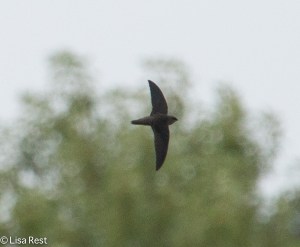Even if there is not much in the way of birds to see or photograph – a distant Baltimore Oriole, a flock of blackbirds flying by – I am still committed to going somewhere every Sunday morning, weather permitting. It has become part of my routine. Routine is great to fall back on when I feel unfocused, overwhelmed or just plain lazy.
So last Sunday I decided to visit Lake Katherine again, and then hop over to McGinnis Slough, which wasn’t far. The forecast was for rain in the afternoon, which in reality never happened. The first bird near the parking lot was this skeptical-looking female Northern Cardinal.
I decided to skip the garden portion and walk around the lake. The first bird to record was likely the same Black-Crowned Night Heron I saw a couple weeks ago in the trees. Although his attempt to hide behind the grasses seemed successful to me, he wasn’t pleased with it and he took off before I could snap a picture of him in flight. When I am the cause of a bird’s flight, I don’t like to photograph it anyway, I feel too much like I’m taking advantage of the situation I created. Not to mention that usually the bird is gone long before I can get myself organized enough to capture it.
It was a cloudy day which made it difficult to photograph anything in flight, actually. But these three helicopters sure were noisy.
Back on the ground, taking note of dragonflies, a Sphinx (“Hummingbird”) Moth and the geometry of a completely stripped thistle blossom.
Juvenile Mallards as big as their parents and at this time of year, looking much the same.
There was a Great Blue Heron stalking prey, but after taking maybe 15 pictures of him crouched low, I grew tired and never did see him catch anything.
The heron was a bit closer when I got around to the other side of the lake.
In the middle of the lake is a small island, and in addition to two small rookery platforms which I did not photograph, there are heron sculptures which looked a lot more interesting.
But my attention to the island was first drawn by a bright orange bird on the other side of it. It’s a Baltimore Oriole that hasn’t left yet. Unfortunately it was too far away to photograph, but I like the branches hanging over the pond lilies anyway.
Lots of Chimney Swifts, which are impossible to follow, but they were so close, I had to try. At least I got one flying cigar photo.
I believe the flower below is a form of evening primrose, of which I understand there are an unbelievable number of varieties. Anyway it looks similar to what has taken over part of my yard.
By the time I got to McGinnis Slough, it was 10:30 AM or so, which is getting late by bird standards. There was not an awful lot happening. Maybe the best bird was a very close Green Heron, but with the clouds and backlighting, it doesn’t appear colorful at all.
It’s impossible to look out on whatever water there is at McGinnis without a scope, so I did the obligatory scan and counted some Pied-Billed Grebes, Great Egrets, Great Blue Herons, Double-Crested Cormorants, and I forget what else – I still have to input my ebird list – there wasn’t much. But there was a Deer Fly who was fascinated by the scope cover. Better the scope cover than me. I am usually swatting at these things, but this one was a model insect. My what beautiful eyes you have.
On the way back to the car, a few Barn Swallows taking a preening break.
The American Goldfinch below is likely a juvenile male, if the faint darkness on his crown is any indication.
Summer continues, although for the moment we’re having brisk fall weather. The days are still long but they get shorter and shorter, and every other week it seems I have to make an adjustment to the length of the timers on the lights in the house, so the indoor birds can see where they’re going during people hours.




























































